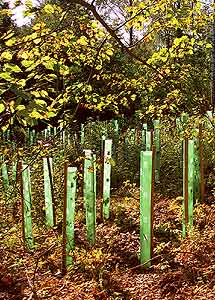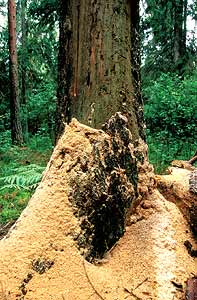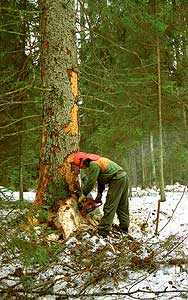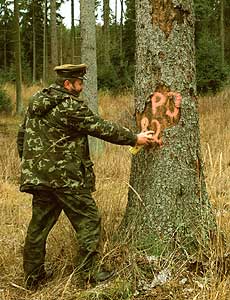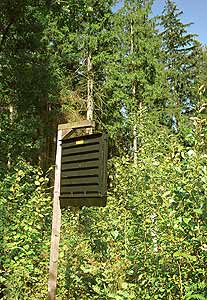|
FORESTS
|
||||||||||||
Text
|
Protective measures in the Park’s forests
In the forests of the national parks, the most important objective of protection is either to preserve the natural structure of the ecosystems or to return them to this state. The most natural areas of the Wigry National Park were excluded from any forms of utilisation by creating zones of strict protection. Of the 623 hectares under strict protection, 283 hectares (45%) are forest. It will not matter if diseases or pests destroy parts of the forest stands; the strict protection regime allows for the natural processes of dying, regeneration (regeneration of forest is when new forest stands grow in sites which were previously occupied also by forest) and growth.
A significant portion of forests in the Park have their species composition, age and spatial structures altered compared with primeval forests. These areas are subject to active protection. The measures undertaken aim principally at facilitating and accelerating the processes of succession (ecological succession is a sequence of developmental changes which plant and animal communities undergo together with their environment), mostly through modifying the species composition of the forest stands.
The tree species which are ill-matching with regard to local conditions will be gradually eliminated and replaced by species more suited to these conditions. In practice, a com-bination of natural factors and protection measures leads to a decrease in the proportion of pines and spruces, and to an increase in the numbers of oaks, maples, lindens etc. This shift in the species composition affects the whole fauna and flora of a forest ecosystem.
A second, but no less important objective of protective measures in forests is to prevent diseases which may threaten the sustainability of stands. The forests in the WNP are healthy but by no means free from any danger. Diseases must be prevented from spreading over large areas and threatening annihilation of old trees. Obviously, the processes of succession will go on even without any intervention by Man. But, following disintegration of a forest stand affected by disease, the process of becoming once again a healthy multi-storey forest stand could take several hundred years. Through applying certain practices, Man tries to maintain forests and accelerate their transformation, because if these are discontinued, the forest will not be able to perform many other important functions, namely: recreational, aesthetic or those supporting tourism and public health. Trees grow slowly while people want to enjoy the benefits of forests now. Various technical measures are applied in order to accelerate natural transformation processes in forests.
Overturned or broken pines and spruces are removed from the forest for two reasons: to prevent proliferation of insects that may endanger the existence of forest stands; and to improve conditions for growth of desirable deciduous species. The removal of trees, dead or dying, as well as those which still stand, is the most effective method for controlling the eight-dentated bark beetle.
But not all these trees are felled and removed. Some are left in forests because they have another important role to play as habitats for many species of fungi, plants and animals.
The objective of reducing the numbers of bark beetles is achieved also by using various types of traps, which contain pheromones, or substances which attract these beetles.
The gaps of thinned sites in forests are planted with seedlings, mostly of species lacking in the surrounding stand. Next, the vegetation which chokes the new generation of trees is removed. These young trees are also nibbled or stripped of bark by red deer, roe deer or elks.
In order to prevent damage, tree plantations are fenced, smeared with repellants or protected by plastic covers. Again, not all plantations are fenced, nor all seedlings covered or smeared with repellants, because forest herbivores have to find available food in the forest.
There are also some measures aimed at attracting deer away from trees by having plots with cultivated plants which can be accessed within forests. All these measures cannot solve the complex issues of protecting forest trees; they must also be combined with a certain planned culling of the populations of forest herbivores. There is also an additional argument in favour of reducing the numbers of deer and wild boars for the damage they inflict on field crops and cultivated fields. The proximity of fields and the abundance of readily accessible food prompt deer and wild boars to go to open areas and eat whatever farmers cultivate. In the areas where this kind of damage is particularly widespread the forest/field edges are also fenced.
The average age of forest stands in the Park is 65 years (the average in Poland is 56). Their species composition, spatial and age structures is mostly too uniform. To transform these forest stands into healthy multi-species and multi-storey stands require felling some trees. Thus, also in this case, a skilfully used powered saw becomes the best tool for a forester who wants to apply the rules of ecology. The trees felled are mostly those which grow in too dense stands, occur in excessive numbers or hamper the growth of trees considered more desirable in forest management.
In line with achieving a more natural character of forest stands, human intervention in the forests of the Wigry National Park will be gradually reduced.
|
|||||||||||
|
|
|
